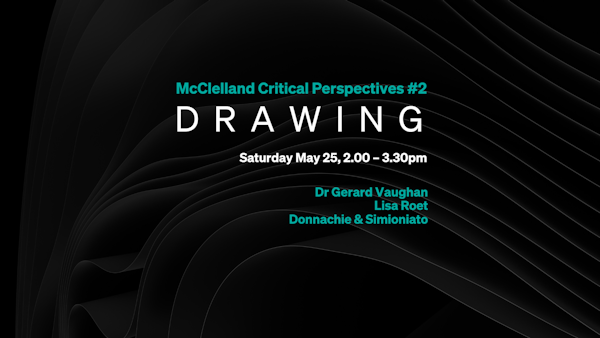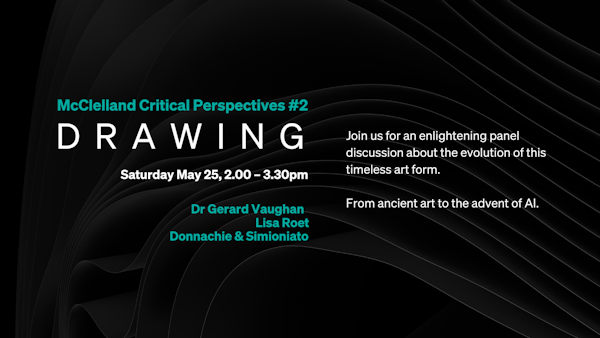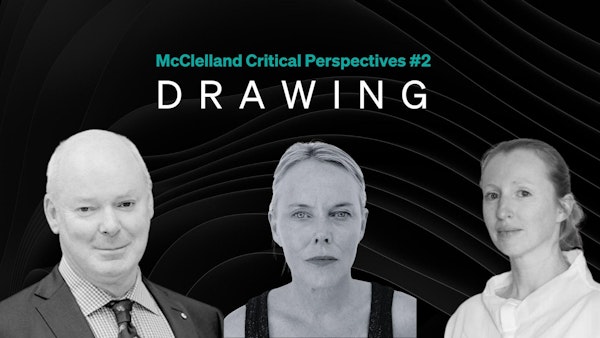


Drawing - Panel Discussion
Saturday 25 May 2024
2 – 3.30pm
**Postponed - new date to be advised asap**
Expert Panel Discussion: The Evolution of Drawing
Speakers; Dr Gerard Vaughan, Lisa Roet, Donnachie & Simioniato
Are you drawn to drawing? If so, join us for an enlightening panel discussion about the evolution of this timeless art form. From ancient art to the advent of AI, we’ll delve into the question: What is drawing now?
We’ll explore the journey from hand-drawn sketches to non-human collaborations and discuss where critical recognition lands for creativity in this evolving space.
Details:
Tickets $12 Adult, $8 Member.
Don’t miss this opportunity to gain insights from experts in the field. Book your place now and be part of this exciting discussion.
Expert Panel Discussion: The Evolution of Drawing
Are you drawn to drawing? If so, join us for an enlightening panel discussion about the evolution of this timeless art form. From ancient art to the advent of AI, we’ll delve into the question: What is drawing now?
We’ll explore the journey from hand-drawn sketches to non-human collaborations and discuss where critical recognition lands for creativity in this evolving space.
Tickets $12 Adult, $8 Member.
Biographies of Speakers
Dr Gerard Vaughan AM
Dr Gerard Vaughan AM is an Australian art historian and museum administrator. He was born in Devonport, Tasmania and educated at the University of Melbourne, where he graduated with a Bachelor of Arts with Honours and a Master of Arts.
From 1981 Vaughan undertook doctoral research at the University of Oxford. He remained in England for 18 years, holding several academic positions, including a research fellowship at Wolfson College, and visiting fellowships at the British School at Rome and Yale University. For several years he served as private secretary to the Vice-Chancellor of Oxford University, then became Deputy Director of the fundraising Campaign for Oxford. In 1994 he was appointed inaugural Director of the British Museum Development Trust in London. From 1983-99 he also served as the UK-based consultant to the Felton Bequest, which supports acquisitions for the NGV.
Vaughan returned to Australia in 1999 to take up the position of Director and CEO of the National Gallery of Victoria, where he was responsible for the NGV’s major building and development program (1999-2003). During his tenure, he prioritised fundraising from the private sector to support building, acquisitions and exhibitions. In 2014 he became director of the National Gallery of Australia, remaining in that role until his retirement in 2018.
Vaughan was made a Member of the Order of Australia for services to the arts, and the French government awarded him the Legion of Honour for his services to the study and promotion of French visual culture. He is chair of the Australian Institute of Art History based at Melbourne University and is the co-chair of the National Reference Group for the First Nations Art Gallery of Australia, planned for Alice Springs.
Karen ann Donnachie and Andy Simionato
Karen ann Donnachie and Andy Simionato have worked exclusively together in the expanded fields of cybernetic art, design, and post-digital publishing since 1989. Together, they create nonhuman collaborative systems for the generation of art and design which leverage technologies such as Computer Vision, Artificial Intelligence and Machine Learning. These autonomous-art-systems, which include robotic scribes capable of writing every tweet by Donald Trump onto a continuous scroll of parchment, nonhuman reading machines which search for poetic patterns of words in existing books in order to autonomously re-publish them through Print-on-Demand services, and computer controlled lasers which generate collages from books while destroying the originals, have been exhibited in solo and group exhibitions internationally. Their automated-art-systems, and the works they generate, have received the highest critical recognition in their fields, including the Robert Coover Award for Electronic Literature (USA), the Cornish Family Prize (AUS), and the Tokyo TDC Grand Prize (JP).
Lisa Roet
Roet’s striking art works created through a researched based practice explores human’s relationship with apes. Drawing on the influence of zoologists, language experts and others, Lisa works through drawing, sculpture, public art and jewellery design as her mediums.
Roet is best known for her giant inflatable sculptures that cling to iconic architecture in metropolises around the world. From Beijing to London the presence of jungle creatures - gorillas, gibbons and chimpanzees - dramatises the dire encroachment of humans on the great apes’ pristine habitats. Environmental concerns are, however, only one facet to her conceptual practice.
Aesthetically rich, diverse and complex, her work always returns to the same terrain – the great ape, human/animal relationships, the degradation of the Earth, species extinction and hope for the future. Roet has become a major voice of the last half-century in exploring how inextricably linked human and animal are in the age of the Anthropocene.
“Using the animal to reflect the human, demystifies the human,” she says. “I’m interested in exploring that liminal state between the rational and the primal. In my work I’m always becoming the ape, or the ape is becoming me.”